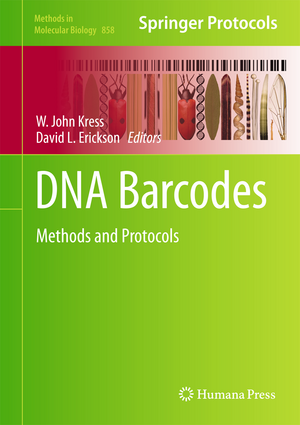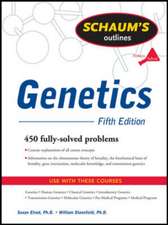DNA Barcodes: Methods and Protocols: Methods in Molecular Biology, cartea 858
Editat de Ida Lopez, David L. Ericksonen Limba Engleză Hardback – 12 iun 2012
Thorough and intuitive, DNA Barcodes: Methods and Protocols aids scientists in continuing to study methods from wet-lab protocols, statistical, and ecological analyses along with guides to future, large-scale collections campaigns.
| Toate formatele și edițiile | Preț | Express |
|---|---|---|
| Paperback (1) | 858.91 lei 6-8 săpt. | |
| Humana Press Inc. – 23 aug 2016 | 858.91 lei 6-8 săpt. | |
| Hardback (1) | 1183.50 lei 6-8 săpt. | |
| Humana Press Inc. – 12 iun 2012 | 1183.50 lei 6-8 săpt. |
Din seria Methods in Molecular Biology
- 9%
 Preț: 791.63 lei
Preț: 791.63 lei - 23%
 Preț: 598.58 lei
Preț: 598.58 lei - 20%
 Preț: 882.98 lei
Preț: 882.98 lei -
 Preț: 252.05 lei
Preț: 252.05 lei - 5%
 Preț: 802.70 lei
Preț: 802.70 lei - 5%
 Preț: 729.61 lei
Preț: 729.61 lei - 5%
 Preț: 731.43 lei
Preț: 731.43 lei - 5%
 Preț: 741.30 lei
Preț: 741.30 lei - 5%
 Preț: 747.16 lei
Preț: 747.16 lei - 15%
 Preț: 663.45 lei
Preț: 663.45 lei - 18%
 Preț: 1025.34 lei
Preț: 1025.34 lei - 5%
 Preț: 734.57 lei
Preț: 734.57 lei - 18%
 Preț: 914.20 lei
Preț: 914.20 lei - 15%
 Preț: 664.61 lei
Preț: 664.61 lei - 15%
 Preț: 654.12 lei
Preț: 654.12 lei - 18%
 Preț: 1414.74 lei
Preț: 1414.74 lei - 5%
 Preț: 742.60 lei
Preț: 742.60 lei - 20%
 Preț: 821.65 lei
Preț: 821.65 lei - 18%
 Preț: 972.30 lei
Preț: 972.30 lei - 15%
 Preț: 660.49 lei
Preț: 660.49 lei - 5%
 Preț: 738.41 lei
Preț: 738.41 lei - 18%
 Preț: 984.92 lei
Preț: 984.92 lei - 5%
 Preț: 733.29 lei
Preț: 733.29 lei -
 Preț: 392.60 lei
Preț: 392.60 lei - 5%
 Preț: 746.26 lei
Preț: 746.26 lei - 18%
 Preț: 962.66 lei
Preț: 962.66 lei - 23%
 Preț: 860.22 lei
Preț: 860.22 lei - 15%
 Preț: 652.64 lei
Preț: 652.64 lei - 5%
 Preț: 1055.50 lei
Preț: 1055.50 lei - 23%
 Preț: 883.87 lei
Preț: 883.87 lei - 19%
 Preț: 491.89 lei
Preț: 491.89 lei - 5%
 Preț: 1038.86 lei
Preț: 1038.86 lei - 5%
 Preț: 524.16 lei
Preț: 524.16 lei - 18%
 Preț: 2122.34 lei
Preț: 2122.34 lei - 5%
 Preț: 1299.23 lei
Preț: 1299.23 lei - 5%
 Preț: 1339.12 lei
Preț: 1339.12 lei - 18%
 Preț: 1390.26 lei
Preț: 1390.26 lei - 18%
 Preț: 1395.63 lei
Preț: 1395.63 lei - 18%
 Preț: 1129.65 lei
Preț: 1129.65 lei - 18%
 Preț: 1408.26 lei
Preț: 1408.26 lei - 18%
 Preț: 1124.92 lei
Preț: 1124.92 lei - 18%
 Preț: 966.27 lei
Preț: 966.27 lei - 5%
 Preț: 1299.99 lei
Preț: 1299.99 lei - 5%
 Preț: 1108.51 lei
Preț: 1108.51 lei - 5%
 Preț: 983.76 lei
Preț: 983.76 lei - 5%
 Preț: 728.16 lei
Preț: 728.16 lei - 18%
 Preț: 1118.62 lei
Preț: 1118.62 lei - 18%
 Preț: 955.25 lei
Preț: 955.25 lei - 5%
 Preț: 1035.62 lei
Preț: 1035.62 lei - 18%
 Preț: 1400.35 lei
Preț: 1400.35 lei
Preț: 1183.50 lei
Preț vechi: 1245.78 lei
-5% Nou
Puncte Express: 1775
Preț estimativ în valută:
226.46€ • 237.29$ • 187.21£
226.46€ • 237.29$ • 187.21£
Carte tipărită la comandă
Livrare economică 11-25 aprilie
Preluare comenzi: 021 569.72.76
Specificații
ISBN-13: 9781617795909
ISBN-10: 1617795909
Pagini: 435
Ilustrații: XV, 470 p.
Dimensiuni: 178 x 254 x 38 mm
Greutate: 1.07 kg
Ediția:2012
Editura: Humana Press Inc.
Colecția Humana
Seria Methods in Molecular Biology
Locul publicării:Totowa, NJ, United States
ISBN-10: 1617795909
Pagini: 435
Ilustrații: XV, 470 p.
Dimensiuni: 178 x 254 x 38 mm
Greutate: 1.07 kg
Ediția:2012
Editura: Humana Press Inc.
Colecția Humana
Seria Methods in Molecular Biology
Locul publicării:Totowa, NJ, United States
Public țintă
Professional/practitionerCuprins
Foreword.-Introduction.-Introduction to Animal DNA Barcoding Protocols.-DNA Barcodes for the Tree of Life – A. Animals - Insects.-Barcoding Methods for Invertebrates.-DNA Barcoding of Amphibians and Reptiles.-DNA Barcoding Fishes.-DNA Barcoding Birds: from Field Collection to Data Analysis.-DNA Barcoding in Mammals.-Methods for DNA Barcoding of Fungi.-Methods for DNA Barcoding Photosynthetic Protists Emphasizing the Macroalgae and Diatoms.-DNA Barcoding Methods for Land Plants.-Field Information Management Systems (FIMS) for DNA Barcoding.-Laboratory Information Management Systems (LIMS) for DNA Barcoding.-DNA Extraction, Preservation and Amplification.-DNA Mini-barcodes.-Next Generation Sequencing: Multiplexing Multiple Barcode Amplicons into Single 454 Run.-The Practical Evaluation of Barcode Efficacy.-Plant DNA Barcodes, Taxonomic Management and Species Discovery in Tropical Forests.-Construction and Analysis of Phylogenetic Trees using DNA Barcode Data.- Phylogenetic Analyses of Ecological Communities Using Barcode Data.-DNA Barcodes: FISH-BOL, a Case Study.-Generating Plant DNA Barcodes for Trees in Long-term Forest Dynamics Plots.- Future Directions.
Textul de pe ultima copertă
A DNA barcode in its simplest definition is one or more short gene sequences taken from a standardized portion of the genome that is used to identify species through reference to DNA sequence libraries or databases. In DNA Barcodes: Methods and Protocols expert researchers in the field detail many of the methods which are now commonly used with DNA barcodes. These methods include the latest information on techniques for generating, applying, and analyzing DNA barcodes across the Tree of Life including animals, fungi, protists, algae, and plants. Written in the highly successful Methods in Molecular Biology™ series format, the chapters include the kind of detailed description and implementation advice that is crucial for getting optimal results in the laboratory.
Thorough and intuitive, DNA Barcodes: Methods and Protocols aids scientists in continuing to study methods from wet-lab protocols, statistical, and ecological analyses along with guides to future, large-scale collections campaigns.
Thorough and intuitive, DNA Barcodes: Methods and Protocols aids scientists in continuing to study methods from wet-lab protocols, statistical, and ecological analyses along with guides to future, large-scale collections campaigns.
Caracteristici
A compendium of the latest information on generating, applying, and analyzing DNA Provides step-by-step detail essential for reproducible results Contatins key notes and implementation advice from the experts







